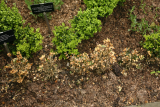Additional notes (click to expand)
Medicinal
Medieval times extracts used for gout, rheumatism, skin disorders and malaria. In ancient Greece used for woulds, jaundice and intoxication (Dioscorides).
Wink, Michael & Ben-Erik van Wyk (2008). Mind-Altering and Poisonous Plants of the World. Timber Press p.73
Other use
Wood is hardest of British trees. Used in rulers, musical instruments, inlay since ancient Egyptians (combs, flutes, furniture, lyres)
Mabberley, D.J. (1997) The Plant Book, ed.2, Cambridge University Press p.110
The use of box to make topiary hedges and sculptures 'is said to have originated with an acquaintance of Julius Caesr'.
Montague-Drake, Blair. (1977). A Biblical Herbal. Earth Images, Australia. p.35
Toxicity
All parts of the plant are poisonous, especially the leaves and bark.
Plants for a Future (2015) at www.plantsforafuture.org.uk http://www.pfaf.org/user/Plant.aspx?LatinName=Buxus+sempervirens
link
Contact with the sap may cause skin irritation. Ingestion causes vomiting and diarrhoea. Poisonous to animals.
Professor Anthony Dayan, 2022
Geographical distribution
- Africa, Northern Africa, Algeria
- Africa, Northern Africa, Libya
- Africa, Northern Africa, Morocco
- Asia-Temperate, Caucasus, Transcaucasus
- Asia-Temperate, Western Asia, Iran
- Asia-Temperate, Western Asia, Turkey
- Europe, Middle Europe, Austria
- Europe, Middle Europe, Belgium
- Europe, Middle Europe, Germany
- Europe, Middle Europe, Switzerland
- Europe, Northern Europe, Great Britain
- Europe, Southeastern Europe, Albania
- Europe, Southeastern Europe, Greece
- Europe, Southeastern Europe, Italy
- Europe, Southeastern Europe, Yugoslavia
- Europe, Southwestern Europe, France
- Europe, Southwestern Europe, Portugal
- Europe, Southwestern Europe, Spain
Podcast
Buxus sempervirens L.
Family: BUXACEAEGenus: Buxus
Species: sempervirens L.
Common names: Common Box
Distribution summary: S.W.Eurasia, N.Africa
Habit: Shrub
Hardiness: H5 - Hardy; cold winter
Habitat: Deciduous woods, scrub, hedgerows, calcareous woods
Garden status: Currently grown
Garden location: Poisons garden (PETO), Europe & Mediterranean (E)
Flowering months: April, May
Reason for growing: Medicinal, toxic

.JPG)


.JPG)
 diseased.JPG)
 diseased.JPG)